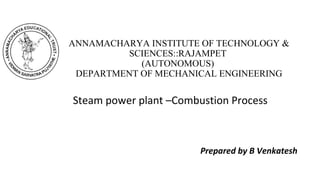Ppe unit 2
- 1. ANNAMACHARYA INSTITUTE OF TECHNOLOGY & SCIENCES::RAJAMPET (AUTONOMOUS) DEPARTMENT OF MECHANICAL ENGINEERING Steam power plant ŌĆōCombustion Process Prepared by B Venkatesh
- 2. Properties of Coal: 1. Energy Content 2. Sulphur Content 3. Burning Characteristics 4. Grind ability 5. Weather ability 6. Ash Softening Temp.,
- 3. Combustion Equipment's: 1. Solid Fuel Fired 2. Liquid Fuel Fired 3. Gaseous Fuel Fired
- 4. Combustion Equipment for Solid fuel selection consideration: 1. Initial cost of the equipment 2. Sufficient combustion Space 3. Area of the grate (Over which fuel burns) 4. Operating cost 5. Minimum smoke nuisance 6. Flexibility of operation 7. Arrangement for through mixing of air with fuel for efficient combustion
- 5. 1 Hand fired A Solid fuel fired 2 Stoker fired a Overfeed Stoker b Underfeed Stoker 3 Pulverised fuel fired a Unit System b central System c Combination of Unit & Centra
- 6. 1 Injection System B Liquid fuel fired 2 Evaporation System 3 Combination of 1 &2
- 7. 1 Atmospheric Pressure System C Gaseous Fuel Fired 2 High Pressure System
- 8. HAND FIRING Various Types of Hand Fired Grates This is a simple method of firing coal into the furnace. It requires no capital investment. It is used for smaller plants. This method of fuel firing is discontinuous process, and there is a limit to the size of furnace which can be efficiently fired by this method.
- 9. Hand fired furnaces are simple in design and can burn the fuel successfully but they have some disadvantages also mentioned below: (i) The efficiency of a hand fired furnace is low. (ii) Attending to furnace requires hard manual labour. (iii) Study process of fuel feed is not maintained.
- 11. Principle of Overfeed Stoker:
- 13. Types of Overfeed Stoker: These Over feed stokers are used for large capacity boiler installation where the coal is burnt with pulverisation 1. Travelling grate stoker: (A) Chain grate type (B) Bar grate type 2. Spreader Stoker Note: Pulverised fuel firing system the coal is reduce to a fine powder with the help of grinding mill and then projected into the combustion chamber with the help of hot air current
- 14. Speed: 15 cm to 50 cm per min
- 27. Equipments for Central and Unit System.
- 28. Chimney:- The most common method to achieve this difference in pressure, the draught, is to provide a chimney. Chimney is a tall hollow structure, which creates the required draught due to difference in pressure from the ground level to some altitude in the atmosphere. 1.Chimneys are made of steel, bricks or concrete. 2.Brick and concrete chimneys are generally used as they have a longer life. 3.The average life of concrete chimneys is about 50 years. 4.The life of steel chimneys is about 25 years, which depends upon the maintenance and care taken to prevent corrosion. 5.Chimneys ere provided with lightning conductor to protect from thunder lightning and aircraft warning light as they are at higher altitudes.
- 29. Draught (or Draft) system:- 1.Draught systems are essential for flue gas propagation. 2.Flue gas propagation is the process of movement of the hot gases from the combustion chamber through boiler pipes, economizer, air pre-heater and finally to the chimney. 3.The function of draught is to supply required quantity of air for combustion, propagate the flues and remove the flues from the system. 4.A difference in pressure is required to move the air through the fuel bed to produce a flow of hot gases i.e., propagation of the flue gases through the boiler, economizer, pre heater and to the chimney by overcoming the pressure losses in the system. 5.This difference in pressure required maintaining a constant flow of air, through the boiler systems and finally to discharge the hot flues to the atmosphere through chimney is termed the draught
- 31. Chimney Height
- 33. Forced Draught
- 34. Balanced Draught
- 36. Cooling Towers
- 37. Wet type:- a)Natural draught cooling tower:- The height of the cooling tower ranges from 50 m to 80 m, with base diameter up to 40 m .
- 38. Forced draught cooling tower
- 39. Dry type:- a) Direct type
- 40. Indirect dry cooling tower with a open type condenser
- 48. SMOKE AND DUST REMOVAL The disposal smoke to the atmosphere is not desirable due to the following reasons : 1. A smoky atmosphere is less healthful than smoke free air. 2. Smoke is produced due to incomplete combustion of coal. This will create a big economic loss due to loss of heating value of coal. 3. In a smoky atmosphere lower standards of cleanliness are prevalent. Buildings, clothings, furniture etc. becomes dirty due to smoke. Smoke corrodes the metals and darkens the paints. In coal fed furnaces the products of combustion contain particles of solid matter floating in suspension. This may be smoke or dust. The production of smoke indicates that combustion conditions are faulty and amount of smoke produced can be reduced by improving the furnace design. TYPES OF DUST COLLECTORS The various types of dust collectors are as follows : 1. Mechanical dust collectors. 2. Electrical dust collectors.
- 64. References: 1.Power Plant Engineering, C. Elanchezhian, L. Saravanakumar, B. Vijaya RamnathI.K. International Publishing House Pvt. Limited, 2007 2.Power Plant Engineering, A. K. Raja, New Age International,2006 3.Power Plant Engineering, P. K. Nag, McGraw-Hill Educatio,2014 4.A Textbook of Power Plant Engineering Fifth Edition (English, Paperback, Rajput R K),2016
































































